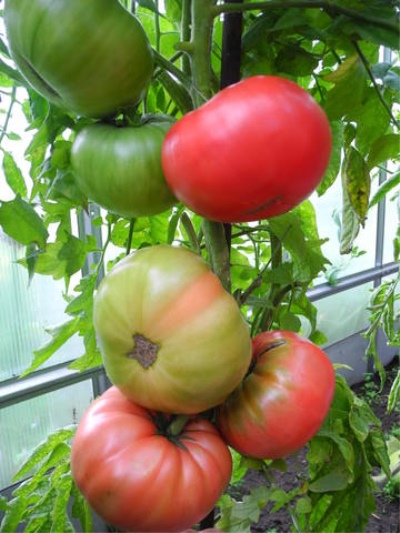
- Authors: Kotelnikova M. A., Antipova N. P. (Agrofirma "Altai Seeds" LLC)
- Year of approval: 2008
- Category: grade
- Growth type: indeterminate
- Appointment: universal
- Ripening period: early
- Ripening time, days: 110-115
- Growing conditions: for open ground
- Marketability: high
- Transportability: high
The Dorodny variety was developed by the specialists of the Altai Seeds agricultural firm. The fruits of this vegetable crop are intended for baby and dietetic nutrition. Tomatoes can be grown throughout the country. They also feel great in neighboring countries.
Description of the variety
It is advisable to cultivate a vegetable crop in open ground conditions. It is an indeterminate variety whose berries have universal significance. Bushes are considered tall. Height - from 1.5 to 2 meters. Leaves are classic green, medium or large in size, covered with small villi. Despite their large growth, the bushes are compact. As it grows, a garter is required to create comfortable conditions for the plants. The inflorescences are simple.
The main qualities of the fruit
Unripe tomatoes have a noticeably dark spot at the stalk. The tomatoes will turn green. Ripe vegetables acquire a bright raspberry color, and the mark at the stalk disappears. The sizes are large, the weight reaches more than 200 grams. Experienced gardeners manage to grow larger tomatoes, weighing about 500 grams. Some specimens can weigh up to 800 grams and are considered champions. The shape is rounded, slightly flattened, with noticeable ribbing. When cut, you can find up to 8 nests filled with seeds. The pulp is fleshy, sugary in the cut. The density is average.
Ripe fruits boast excellent keeping quality and high resistance to cracking. Due to their high commercial qualities and the ability to withstand long-term transportation, Dorodny tomatoes are often grown commercially. The crop is also used to make delicious sauces, juices and dressings.
Taste characteristics
The taste of this variety is high. Ripe fruits are sweet, without sour taste. During the fruiting season, tomatoes are eaten fresh, enjoying their natural taste. They make wonderful light snacks and salads. Excellent gastronomic characteristics can only be achieved with proper care and cultivation.
Ripening and fruiting
Plump belongs to varieties with an early ripening period. From the moment of emergence to the first harvest, 110 to 115 days pass. One of the special characteristics is long-term fruiting. Tomatoes are harvested in the last two months of summer.
Yield
The yield is high. 4.2 kg of ripe vegetables are harvested from one square meter of the plantation.
The timing of planting seedlings and planting in the ground
To get good seedlings, sowing seedlings should be done in early spring (early or mid March).
Seedling growing process:
- the seed is germinated in fertile soil;
- containers with seeds are covered with foil or transparent glass;
- the shelter is removed after the first shoots appear;
- after removing the shelter, the seedlings continue to germinate until two full-fledged leaves appear;
- then the seedlings are dived in separate containers;
- seedlings continue to germinate for another 14 days, leaving the container in a sunny place;
- after 2 weeks, top dressing is applied to the soil for the first time.
As soon as the seedlings are 60-65 days old, young plants are transplanted to a permanent place. By this time, 6-7 true leaves should appear on each bush. After transplanting, the tomatoes are fertilized three more times as they grow. Also, do not forget about other rules of agricultural technology.

Growing tomato seedlings is an extremely important process, because it largely depends on whether the gardener will be able to harvest at all. All aspects must be taken into account, from seedbed preparation to planting in the ground.
Landing scheme
Gardeners recommend the following scheme for planting - 50x40 centimeters. The maximum planting density is 3-4 plants per square meter.

Growing and care
Caring for the bushes consists in performing the following procedures:
- weeding to clear the area of weeds;
- irrigation simultaneously with loosening the topsoil;
- pinching and garter shoots;
- preventive treatment for diseases and insects.
In order for the crop to ripen at the same time, regular pruning of the lower leaves should be performed. So the bushes will give nutrients to the growth of tomatoes, and not to the formation of green mass. Fertilizers are applied during flowering, when setting ovaries and when tomatoes are ripening.
The variety loves regular watering, but moisture stagnation cannot be allowed. High humidity negatively affects the root system, it begins to rot, and the plant dies. A humid climate encourages fungal growth.
Harvested as it ripens. If you leave ripe tomatoes on the branches, the bushes will not have enough strength to ripen green vegetables. When cultivated, the bushes are formed into 1-2 stems.




A plant needs different micronutrients at each stage of growth. All fertilizers can be divided into two groups: mineral and organic. Folk remedies are often used: iodine, yeast, bird droppings, eggshells.
It is important to observe the rate and period of feeding. This also applies to folk remedies and organic fertilizers.


Resistant to adverse weather conditions
The Dorodny variety grows and bears fruit remarkably in cold climates. Due to this characteristic, tomatoes are often grown in the northern regions of the country.

























































































